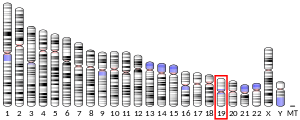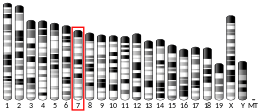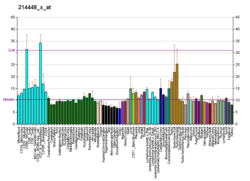NFKBIB
NF-kappa-B inhibitor beta is a protein that in humans is encoded by the NFKBIB gene.[5]
Function
NFKB1 (MIM 164011) or NFKB2 (MIM 164012) is bound to REL (MIM 164910), RELA (MIM 164014), or RELB (MIM 604758) to form the NFKB complex. The NFKB complex is inhibited by I-kappa-B proteins (NFKBIA, MIM 164008, or NFKBIB), which inactivate NF-kappa-B by trapping it in the cytoplasm. Phosphorylation of serine residues on the I-kappa-B proteins by kinases (IKBKA, MIM 600664 or IKBKB, MIM 603258) marks them for destruction via the ubiquitination pathway, thereby allowing activation of the NF-kappa-B complex. Activated NFKB complex translocates into the nucleus and binds DNA at kappa-B-binding motifs such as 5-prime GGGRNNYYCC 3-prime or 5-prime HGGARNYYCC 3-prime (where H is A, C, or T; R is an A or G purine; and Y is a C or T pyrimidine).[supplied by OMIM][6]
Interactions
NFKBIB has been shown to interact with:
References
- ENSG00000282905 GRCh38: Ensembl release 89: ENSG00000104825, ENSG00000282905 - Ensembl, May 2017
- GRCm38: Ensembl release 89: ENSMUSG00000030595 - Ensembl, May 2017
- "Human PubMed Reference:". National Center for Biotechnology Information, U.S. National Library of Medicine.
- "Mouse PubMed Reference:". National Center for Biotechnology Information, U.S. National Library of Medicine.
- Okamoto T, Ono T, Hori M, Yang JP, Tetsuka T, Kawabe T, Sonta S (November 1998). "Assignment of the IkappaB-beta gene NFKBIB to human chromosome band 19q13.1 by in situ hybridization". Cytogenet Cell Genet. 82 (1–2): 105–6. doi:10.1159/000015077. PMID 9763672.
- "Entrez Gene: NFKBIB nuclear factor of kappa light polypeptide gene enhancer in B-cells inhibitor, beta".
- Woronicz JD, Gao X, Cao Z, Rothe M, Goeddel DV (October 1997). "IkappaB kinase-beta: NF-kappaB activation and complex formation with IkappaB kinase-alpha and NIK". Science. 278 (5339): 866–9. doi:10.1126/science.278.5339.866. PMID 9346485.
- Chen Y, Wu J, Ghosh G (June 2003). "KappaB-Ras binds to the unique insert within the ankyrin repeat domain of IkappaBbeta and regulates cytoplasmic retention of IkappaBbeta x NF-kappaB complexes". J. Biol. Chem. 278 (25): 23101–6. doi:10.1074/jbc.M301021200. PMID 12672800.
- Suyang H, Phillips R, Douglas I, Ghosh S (October 1996). "Role of unphosphorylated, newly synthesized I kappa B beta in persistent activation of NF-kappa B". Mol. Cell. Biol. 16 (10): 5444–9. doi:10.1128/mcb.16.10.5444. PMC 231544. PMID 8816457.
- Na SY, Kim HJ, Lee SK, Choi HS, Na DS, Lee MO, Chung M, Moore DD, Lee JW (February 1998). "IkappaBbeta interacts with the retinoid X receptor and inhibits retinoid-dependent transactivation in lipopolysaccharide-treated cells". J. Biol. Chem. 273 (6): 3212–5. doi:10.1074/jbc.273.6.3212. PMID 9452433.
Further reading
- Lee JW, Choi HS, Gyuris J, Brent R, Moore DD (1995). "Two classes of proteins dependent on either the presence or absence of thyroid hormone for interaction with the thyroid hormone receptor". Mol. Endocrinol. 9 (2): 243–54. doi:10.1210/me.9.2.243. PMID 7776974.
- Harhaj E, Blaney J, Millhouse S, Sun SC (1996). "Differential effects of I kappa B molecules on Tat-mediated transactivation of HIV-1 LTR". Virology. 216 (1): 284–7. doi:10.1006/viro.1996.0062. PMID 8615004.
- DiDonato J, Mercurio F, Rosette C, Wu-Li J, Suyang H, Ghosh S, Karin M (1996). "Mapping of the inducible IkappaB phosphorylation sites that signal its ubiquitination and degradation". Mol. Cell. Biol. 16 (4): 1295–304. PMC 231113. PMID 8657102.
- Beauparlant P, Kwon H, Clarke M, Lin R, Sonenberg N, Wainberg M, Hiscott J (1996). "Transdominant mutants of I kappa B alpha block Tat-tumor necrosis factor synergistic activation of human immunodeficiency virus type 1 gene expression and virus multiplication". J. Virol. 70 (9): 5777–85. PMC 190591. PMID 8709193.
- Suyang H, Phillips R, Douglas I, Ghosh S (1996). "Role of unphosphorylated, newly synthesized I kappa B beta in persistent activation of NF-kappa B". Mol. Cell. Biol. 16 (10): 5444–9. doi:10.1128/mcb.16.10.5444. PMC 231544. PMID 8816457.
- Whiteside ST, Epinat JC, Rice NR, Israël A (1997). "I kappa B epsilon, a novel member of the I kappa B family, controls RelA and cRel NF-kappa B activity". EMBO J. 16 (6): 1413–26. doi:10.1093/emboj/16.6.1413. PMC 1169738. PMID 9135156.
- DiDonato JA, Hayakawa M, Rothwarf DM, Zandi E, Karin M (1997). "A cytokine-responsive IkappaB kinase that activates the transcription factor NF-kappaB". Nature. 388 (6642): 548–54. doi:10.1038/41493. PMID 9252186.
- McKinsey TA, Chu ZL, Ballard DW (1997). "Phosphorylation of the PEST domain of IkappaBbeta regulates the function of NF-kappaB/IkappaBbeta complexes". J. Biol. Chem. 272 (36): 22377–80. doi:10.1074/jbc.272.36.22377. PMID 9278383.
- Woronicz JD, Gao X, Cao Z, Rothe M, Goeddel DV (1997). "IkappaB kinase-beta: NF-kappaB activation and complex formation with IkappaB kinase-alpha and NIK". Science. 278 (5339): 866–9. doi:10.1126/science.278.5339.866. PMID 9346485.
- Na SY, Kim HJ, Lee SK, Choi HS, Na DS, Lee MO, Chung M, Moore DD, Lee JW (1998). "IkappaBbeta interacts with the retinoid X receptor and inhibits retinoid-dependent transactivation in lipopolysaccharide-treated cells". J. Biol. Chem. 273 (6): 3212–5. doi:10.1074/jbc.273.6.3212. PMID 9452433.
- Lee FS, Peters RT, Dang LC, Maniatis T (1998). "MEKK1 activates both IκB kinase α and IκB kinase β". Proc. Natl. Acad. Sci. U.S.A. 95 (16): 9319–24. doi:10.1073/pnas.95.16.9319. PMC 21336. PMID 9689078.
- Zandi E, Chen Y, Karin M (1998). "Direct phosphorylation of IkappaB by IKKalpha and IKKbeta: discrimination between free and NF-kappaB-bound substrate". Science. 281 (5381): 1360–3. doi:10.1126/science.281.5381.1360. PMID 9721103.
- Blázquez MV, Macho A, Ortiz C, Lucena C, López-Cabrera M, Sánchez-Madrid F, Muñoz E (1999). "Extracellular HIV type 1 Tat protein induces CD69 expression through NF-kappaB activation: possible correlation with cell surface Tat-binding proteins". AIDS Res. Hum. Retroviruses. 15 (13): 1209–18. doi:10.1089/088922299310304. PMID 10480634.
- Wu C, Ghosh S (1999). "beta-TrCP mediates the signal-induced ubiquitination of IkappaBbeta". J. Biol. Chem. 274 (42): 29591–4. doi:10.1074/jbc.274.42.29591. PMID 10514424.
- Kumar A, Dhawan S, Mukhopadhyay A, Aggarwal BB (2000). "Human immunodeficiency virus-1-tat induces matrix metalloproteinase-9 in monocytes through protein tyrosine phosphatase-mediated activation of nuclear transcription factor NF-kappaB". FEBS Lett. 462 (1–2): 140–4. doi:10.1016/S0014-5793(99)01487-8. PMID 10580107.
- Fenwick C, Na SY, Voll RE, Zhong H, Im SY, Lee JW, Ghosh S (2000). "A subclass of Ras proteins that regulate the degradation of IkappaB". Science. 287 (5454): 869–73. doi:10.1126/science.287.5454.869. PMID 10657303.
- Manna SK, Aggarwal BB (2000). "Differential requirement for p56lck in HIV-tat versus TNF-induced cellular responses: effects on NF-kappa B, activator protein-1, c-Jun N-terminal kinase, and apoptosis". J. Immunol. 164 (10): 5156–66. doi:10.4049/jimmunol.164.10.5156. PMID 10799874.
- Li X, Josef J, Marasco WA (2001). "Hiv-1 Tat can substantially enhance the capacity of NIK to induce IkappaB degradation". Biochem. Biophys. Res. Commun. 286 (3): 587–94. doi:10.1006/bbrc.2001.5442. PMID 11511100.
- Page M, Tuckerman EM, Li TC, Laird SM (2002). "Expression of nuclear factor kappa B components in human endometrium". J. Reprod. Immunol. 54 (1–2): 1–13. doi:10.1016/S0165-0378(01)00122-X. PMID 11839392.





